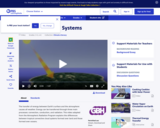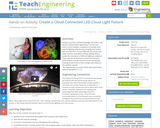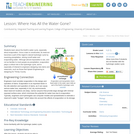
This module depicts the brief overview of Cloud Computing
- Subject:
- Computer Science
- Material Type:
- Module
- Author:
- P.Muthamil Selvi
- Date Added:
- 08/26/2019

This module depicts the brief overview of Cloud Computing

This video segment adapted from the Atmospheric Radiation Program explains the differences in the formation of tropical convective cloud systems over islands and over the ocean.

Students put their STEAM knowledge and skills to the test by creating indoor light fixture “clouds” that mimic current weather conditions or provide other colorful lighting schemes they program and control with smartphones. Groups fabricate the clouds from paper lanterns and pillow stuffing, adding LEDs to enable the simulation of different lighting conditions. They code the controls and connect the clouds to smart devices and the Internet cloud to bring their floating clouds to life as they change color based on the weather outside.

In the year 1970’s when relational database came into picture, data schema to be worked upon were reasonably elemental and simple wherein the data items were to be arranged as a set of formally described tables with rows and columns. But with the need to store volumes and variety of data (unstructured) in recent years, non-relational database technologies (document-oriented, graph based, column based, key-value and hybrid) have emerged to address the requirement that allow data to be grouped together more naturally and logically. One of the most popular ways of storing data is a document-oriented database, basically employed for storing, managing and retrieval of semi-structured data where each record and its associated data is considered of as a “document”. A document-oriented database is also termed as a document store or simple document, is one of the kind of NoSQL database.

Green computer will be one of the major contributions, which will break down the 'digital divide', the electronic gulf that separates the information rich from the information poor.

With the expansion of huge and complex real time data that is wandering across the internet today, the dimensions of data transmitted are escalating exponentially with each passing years. This makes working with standard database systems or on personal computers difficult because of its inability to handle outsized, unstructured and complicated data. Various institutes stores and uses massive amounts of data which are further utilized for generating reports to guarantee stability regarding the services they proposes. However, the challenge is how to analyze, capture, share, store, transfer, visualize, query, update and finally manipulate an impressive volume of data that has to be delivered through the internet to reach its destination intact maintaining its information privacy. Almost all the applications developed using any programming languages requires some external component to store and access data. The components for the same could be a local network, a cloud file or even a database. While sources like the network and cloud file systems store the unstructured data, the structured data is usually stored in a typical Relational Database Management System or RDBMS. The RDBMS operates with relational data model using schema for storing data into tables and is usually queried with SQL (Structured Query Language) for data operations. Usually it’s a time consuming process to define, structure, distribute and access data from RDBMS through SQL and hence, an alternative was developed for this called the NoSQL ("Non SQL", "Non relational" or "Not only SQL") database. This edited book chapter provides NoSQL databases hands on and attention has been paid to various types of NoSQL databases focusing on the details such as installation, creation, modification and various updation of one database belonging to each type.

Students learn about the Earth's water cycle, especially about evaporation. Once a dam is constructed, its reservoir becomes a part of the region's natural hydrologic cycle by receiving precipitation, storing runoff water and evaporating water. Although almost impossible to see, and not as familiar to most people as precipitation, evaporation plays a critical role in the hydrologic cycle, and is especially of interest to engineers designing new dams and reservoirs, such as those that Splash Engineering is designing for Thirsty County.